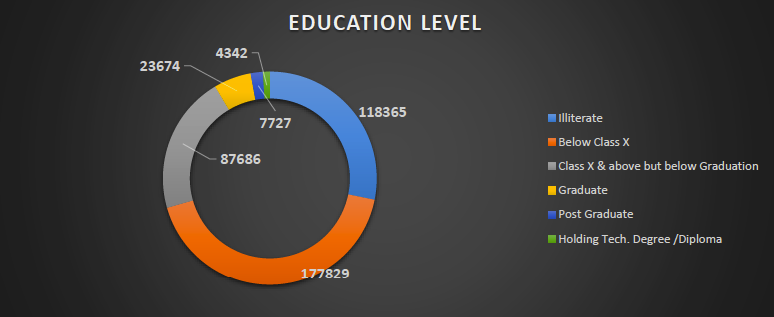[orc]Based on the ‘Prison Statistics Report 2015‘ (PSI) released by the NCRB, here is a compilation of ten important things about Indian Prisons by ‘The Commonwealth Human Rights Initiative’ (CHRI)
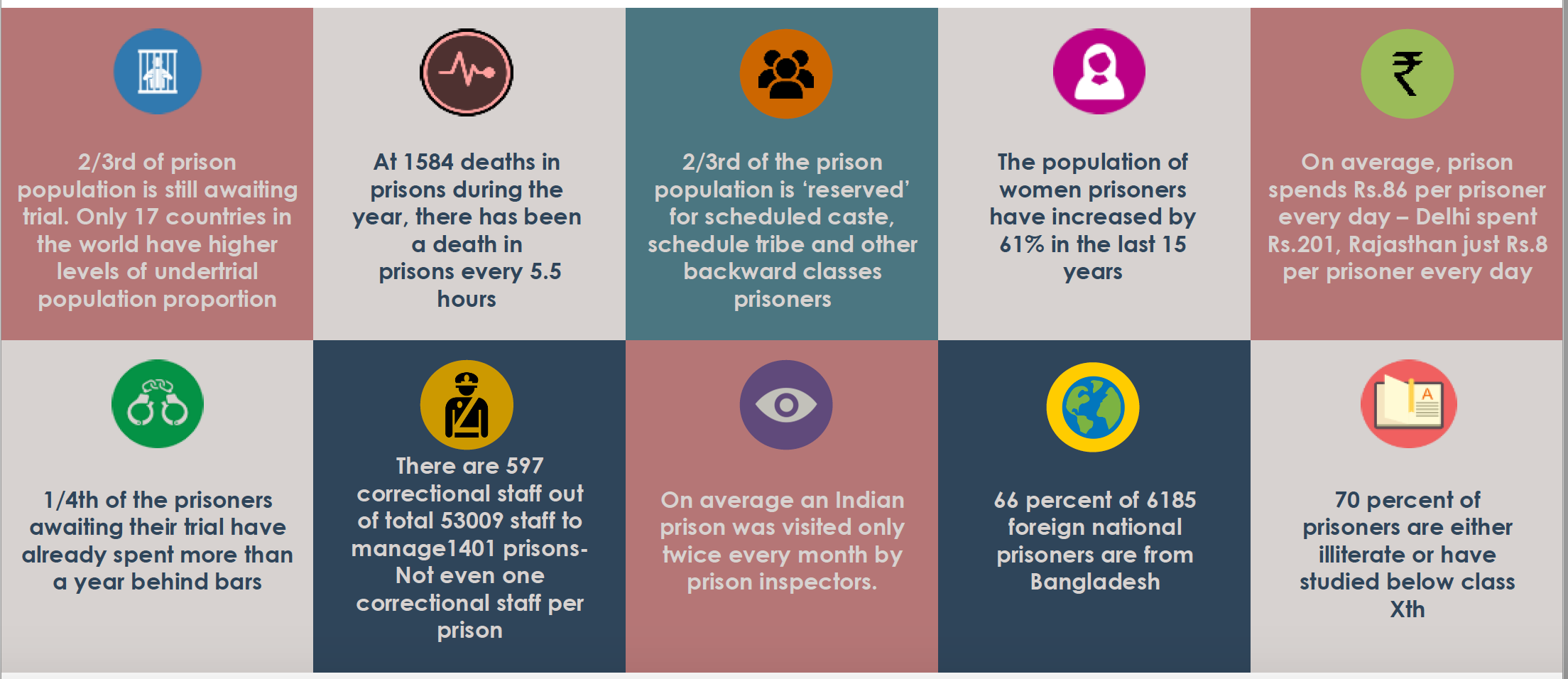 I. PROPORTION OF UNDERTRIAL PRISONERS
I. PROPORTION OF UNDERTRIAL PRISONERS
- Seven out of ten prisoners behind bars are still awaiting trial. This has been the case for more than a decade.
- The situation in Bihar and Jammu & Kashmir is even worse with 82 percent and 81 percent prison undertrial population.
- Uttarakhand, Tamil Nadu, Mizoram and Tripura are few states where there are as many undertrials as convicts.
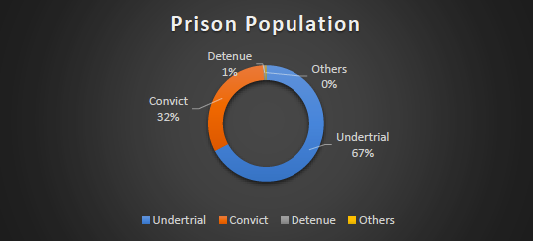
CHRI’s Comment: Such high proportion of undertrial prisoners points directly to the dysfunctions across the criminal justice system. India ranks 18th (out of 212 countries) for such high levels of undertrial population. Even Uganda and United Arab Emirates do better while countries such as Libya, Bolivia and Liberia rank worse. In the sub-continent, Sri Lanka and Nepal at 52.8 percent and 58.9 percent do much better than India in holding down the numbers in pre-trial detention while Pakistan and Bangladesh are only marginally worse with 69.1 percent and 73.8 percent respectively. Unnecessary arrests, sluggish pace of criminal trials, deliberate delays to suit administrative convenience, and inadequate security and escort staff to ferry prisoners back and forth from prison to court and vacancies in the magistracy are the primary culprits. The consequence are overcrowded prisons and sub-human prison conditions.
II. PERIOD OF DETENTION
- One fourth of undertrial prisoners have been inside prison for more than a year
- Three out of every ten undertrial prisoners have spent less than 3 months behind bars.
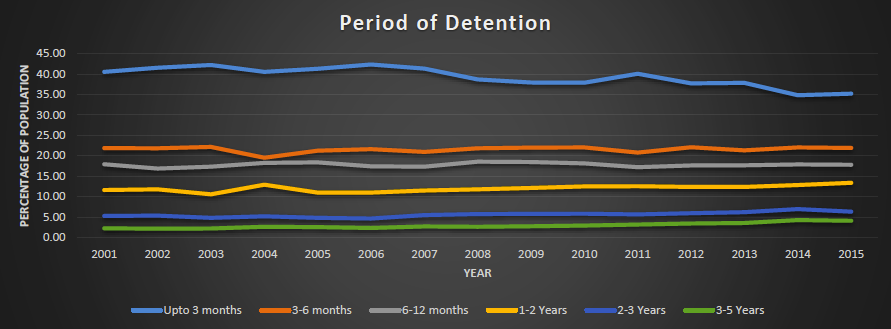
CHRI’s Comment: Trials are taking longer to complete and more prisoners now spend longer in jail than before. In 2001 19% spent more than a year in prison awaiting trial now 25% do. Similarly in 2001, 40 percent had spent less than 3 months in prison, now 35 percent do. The proportion of prisoners who have spent less than three months in prison has decreased from 40 percent in 2001 to 35 percent in 2015. Despite all the ‘mission mode’ programmes and attempts to ‘speed up’ trials, the unfortunate reality is that the liberty of those whose guilt has not been established is being curtailed for even longer periods than before. CHRI has been assisting the Supreme Court, through the Amicus Curiae in the writ petition Re-Inhuman Conditions in 1382 Prisons, on the working of the Undertrial Review Committees (UTRCs) with the objective to reduce un-necessary detention. CHRI’s national report on UTRCs ‘Circle of Justice’ would be released on 8th November 2016.
III. DEATHS INSIDE PRISON
- There is a death inside Indian prisons every 5 and a half hours.
- One suicide in Indian prisons every five days. The propensity to commit suicide inside prisons is almost twice than outside.
- 19 deaths have been reported as ‘others’. The ‘others’ column has been a part of PSI all along but always explained.
- With 323 deaths Uttar Pradesh prisons witnessed maximum deaths. However adjusting for prison population, Punjab with death rate of 752 is the death capital of Indian prisons
 CHRI’s Comment: Too many prisoners are dying behind bars. Most are reported as ‘Natural Deaths’. Natural deaths inside custody however need further scrutiny. Firstly because the person’s liberty is fettered in judicial custody; he/she is dependent on the state for the upkeep of their health. So, deprivation in this area cannot be termed ‘natural’. Secondly because the status of the inquiries conducted to investigate these deaths are not available in public domain. Suicides form the largest chunk of unnatural deaths. The NHRC has recently published a report on prison suicides. It is the responsibility of every prison department to follow the preventive measures the report recommends. Also, mentioning an unspecified category such as ‘others’ does not make for a useful data category in understanding the causes of prison deaths.
CHRI’s Comment: Too many prisoners are dying behind bars. Most are reported as ‘Natural Deaths’. Natural deaths inside custody however need further scrutiny. Firstly because the person’s liberty is fettered in judicial custody; he/she is dependent on the state for the upkeep of their health. So, deprivation in this area cannot be termed ‘natural’. Secondly because the status of the inquiries conducted to investigate these deaths are not available in public domain. Suicides form the largest chunk of unnatural deaths. The NHRC has recently published a report on prison suicides. It is the responsibility of every prison department to follow the preventive measures the report recommends. Also, mentioning an unspecified category such as ‘others’ does not make for a useful data category in understanding the causes of prison deaths.
IV. CASTE AND RELIGION
- Two –thirds of the prison population has been ‘reserved’ for Schedule Caste(SC), Schedule Tribe(ST) and Other Backward Classes(OBC)
- 92 percent of Tamil Nadu’s prison population are SC, ST &OBC inmates
- Hindus form 71 percent of the prison population whereas Muslims form 19 percent.
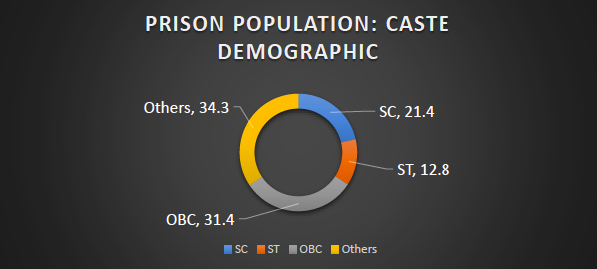
CHRI’s Comment: A disproportionate 65 percent of the prison population is made up of Schedule Caste, Schedule Tribes, and Other Backward Classes. There has been miniscule variations in this proportion over the years. As per the PSI 2015 data, Schedule castes form 21.4 percent of the prison population, while they form 16.6% of the general population as per the 2011 Census data. Similarly Schedule Tribes form 12.8% of the prison population whereas only 8.6% of the general population. Muslims form 15 percent of the country’s population but 19% of the prison population.
V. EDUCATIONAL QUALIFICATION OF PRISONERS
- 28 percent of the prison population is illiterate
- 6 percent are graduates and 2 percent post graduates
- In West Bengal 83 percent of the prisoners are either illiterate or have studied up to class X
CHRI’s Comment: 70 percent of the prisoners are either illiterate or have been educated below Class X. These segments are easy to target, know little or nothing of their rights, are unable to challenge police procedures or ensure they have the benefit of good representation or insist on fair trial procedures. At the mercy of an over strained and burdened system they are its ultimate victims.
VI. Prison Officials And Staff
- 80236 prison officials and staff have been sanctioned to manage Indian prisons.
- Due to 34 percent vacancies, prisons are actually being managed by 53009 prison staff
- There are 597 correctional staff in total for 1401 prisons- not even one per prison
- 18 psychiatrist/psychologists for the entire prison population in the country. One for every 23,000
CHRI’s Comment: Prison officials and staff includes officers, cadre staff, correctional staff, medical staff, ministerial staff and others. Jail cadre forms more than 70 percent of the force. The Model Jail Manual 2016 recommends there should be one guarding staff for every six inmates. In reality it is almost half the standard with 10 prisoners per guarding staff. Without the augmentation of guarding staff and correctional staff, prisons will stay fixed in adversarial staff-inmate relations, in a culture of punishment with extra lock-up hours to serve ‘effective’ management. PSI figures indicate the obvious huge short staffing of prisons. But even this tells just half the story of the sorry state of prison services. Many staff are on suspension or absent on leave or on ancillary and administrative work. Prisons too often rely on convict warders who prison staff must rely on heavily to control the prison. Prison service staff are ill-trained, poorly paid, badly accommodated and often remain without promotion or any career advancement for years together. Senior positions of responsibility are inevitably filled by higher ranking personnel from the police who have neither the training nor experience to run prisons as anything more than holding cells with no thought of them possibly being correctional facilities as the policies on paper seem to suggest they should be.
VII. Women Prisoners
- Women prisoners formed 4.3 % of the prison population.
- 51 women inmates were reported dead in prison in 2015
- There were 1597 women prisoners with 1866 children inside prison as on 31st December 2015
CHRI’s Comment: As per the September 2015 report by the World Prison Brief and Institute of Criminal Policy Research, since the year 2000, the population levels of women prisoners have grown much faster than male prison population levels. The number of women and girls in prison have increased by 50 percent in the past 15 years. India too has seen an increase in population of women prisoners. With a population of 11094, women inmates formed 3.5 percent of prison population in 2001. 15 years later, Indian prisons house 17834 women inmates, an increase of 61 percent. Therefore their share in prison population has gone up to 4.3 percent. In the last decade, 477 women inmates have died inside prison.
VIII. PRISON INSPECTIONS
- There were 2 inspections per prison per month by prison inspectors.
- Medical inspections form 43 percent whereas Judicial inspections form 30 percent of the total inspections
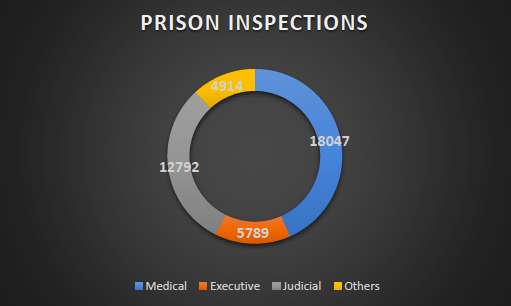
CHRI’s Comment: Every prison in the country is required to be inspected or ‘visited’. Regular visits are mandated by law and visitors include magistrates and judges, human rights commissions, officers from public works, medical and health, social welfare departments and respected people drawn from local society. They can make individual and collective visits, surprise and scheduled visits to listen to prisoners’ grievances, identify areas of concern, and seek resolution of problems. Board of Visitors made up of local officials and folks drawn from the area are required to come together to make reports and monitor improvements. CHRI’s recent report ‘Looking Into The Haze: A National Study on Monitoring of Jails in India’ to be released on 8th November shows that across India Boards of Visitors are rarely operational, where they are they do not meet at all regularly, do not fulfil mandates nor report back to the jail department as they should, non-official visitors are not appointed in most states and visits when they take place are limited to charitable distributions on formal occasions like Diwali or Republic Day where there is little opportunity to transact the business of inspection with any seriousness. The NCRB data segregates inspections to categories of inspections by’ Medical’, ‘Executive’, ‘Judicial’ and ‘Other’ inspections. The average of two visits a month may appear reasonable but it is not clear whether every prison benefitted from two visits each month. Given CHRI’s findings this regularity is very doubtful. As is the efficacy of visits. Prison wise data that indicates the periodicity of visits and whether Boards have been constituted and non-official visitors appointed would assist in defining the quality of inspections, or indicate what was seen and heard, what was recommended for improvement and followed up on. So poor is the oversight of prisons that the Supreme Court has taken on to itself the task of monitoring prisons through the judiciary as well as monitoring and directing the rectification of the system through an on-going case aptly named “ Inhuman Conditions in 1382 Prisons’ The NCRB does not provide any useful insight due to amorphous classification of data into vague heads of ‘Medical, ‘Executive’, ‘Judicial’ and ‘Other’ inspections. Even from the little data that is provided, it is visible that on average an Indian prison was visited only twice every month in 2015 – that is after we assume that all prisons were visited. Although, the total number of inspections have increased, what is more important is that the monthly inspection rate remains the same since 2005. CHRI has been advocating for the implementation of the statutory requirement of the constitution of Board of Visitors (BOV) in every jail for effective prison monitoring.
IX. EXPENDITURE ON A PRISONER PER DAY
- The prison department spends Rs 86 per prisoner every day. Rs 52 of this is on food.
- Bihar, Delhi and Nagaland spend the most on prisoners – Rs 229, 201 and 179 per day respectively
- Punjab spends Rs 45 per prisoner and Rajasthan Rs 8 per prisoner.
- Hardly any amount is spent on vocation training and education. 14 states and union territories do not spend on vocation and education of prisoners at all.
- The prison budget has increased by 20% from 2014 to 2015.
CHRI’s Comment: There has been an increase in the expenditure on prisoners over the years. However that has not translated into an improvement in the quality and condition of life inside prisons. Rajasthan surprisingly only spent rupees 8 per prisoner. Also, there is an unreasonable variation in the spending on the prison in different states. The majority of the funds sanctioned are allocated to food and clothing. Resources have not been allocated to vocational and education purposes. This directly impacts the health of the prison.
X. FOREIGN NATIONAL PRISONERS
- There were 6185 foreign national prisoners in Indian Prisons. 2363 are convicted, 37 are detenues and the rest 3795 are awaiting trial,
- 66 percent of foreign national prisoners are from Bangladesh. 80 percent of them are housed in West Bengal
- More than half of foreign national prisoners are housed in West Bengal
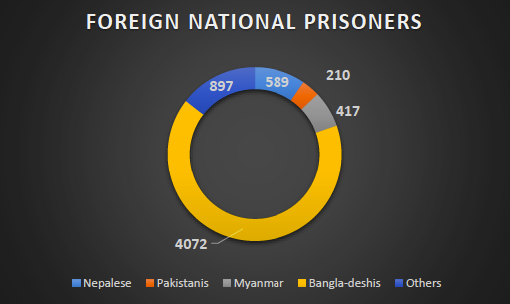
CHRI’s Comment: There were 6185 foreign prisoners in India as on 31st December, 2015. As with other Indian inmates, more than half were awaiting or undergoing trial. Bengal’s prisons house more than half the total foreign prisoners in the country. 98 percent of these are Bangladesh nationals. Roughly 70 percent of all the convicts booked mainly under Section 14 of the pre-colonial Foreigners Act were also lodged in West Bengal. NCRB data does not take account of the numbers of foreigners whose prison term is over but who remain in prison for want of assistance and means to return to their own countries. They continue to remain incarcerated well past the official date of their release. The website of West Bengal Correctional Services reveals that till 1st May, 2016 it housed a total 21530 prisoners against the capacity of 20496. It is important to note that the foreign overstays constituted 3 percent of the total population. The proportion could have been more with the inclusion of their children. Despite bilateral agreements for repatriation lack of diligent consular assistance, restrictions on making restrictions on making international calls to family, lack of implementation of agreements on transferring of prisoners between India and Bangladesh, sketchy application of deportation/repatriation procedures and absence of alternative facilities to house the released prisoners contribute to this enormous humanitarian and administrative problem.


